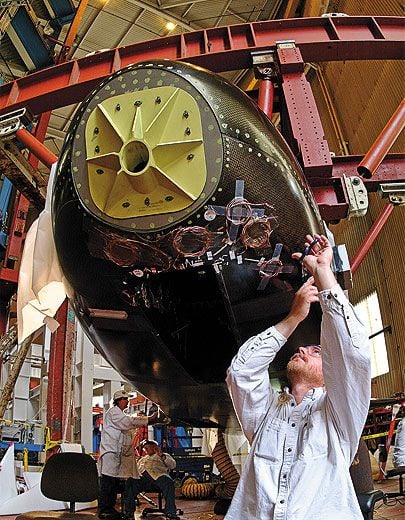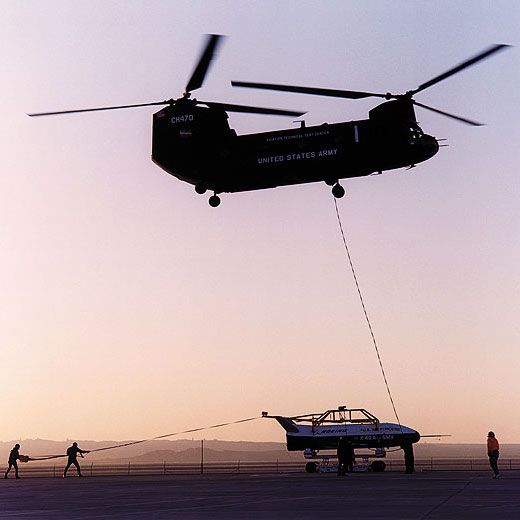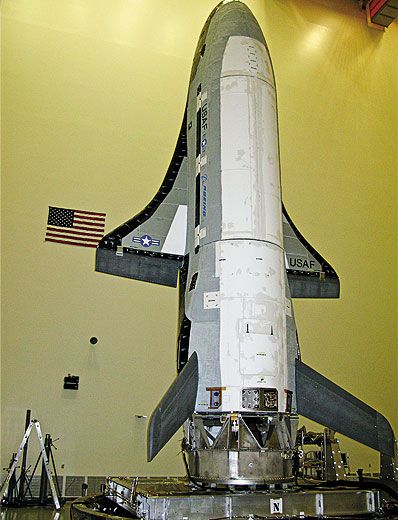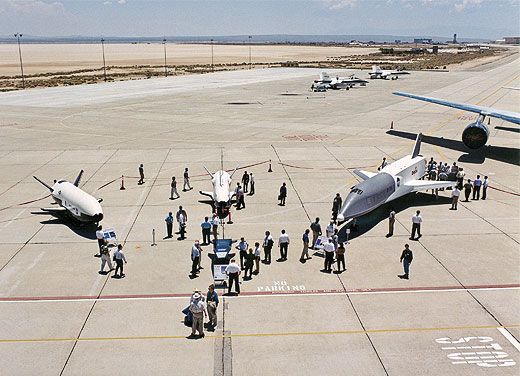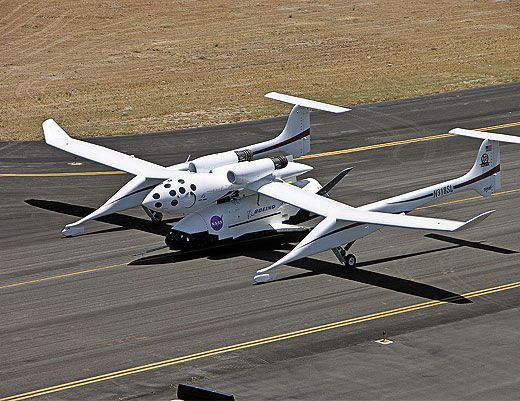Space Shuttle Jr.
After 2010, the only spaceplane in the U.S. inventory will be the Air Force’s mysterious X-37.
/https://tf-cmsv2-smithsonianmag-media.s3.amazonaws.com/filer/09N_DJ10-flash.jpg)
It's been a long wait—in some ways, more than 50 years—but in April 2010, the U.S. Air Force is scheduled to launch an Atlas V booster from Cape Canaveral, Florida, carrying the newest U.S. spacecraft, the unmanned X-37, to orbit. The X-37 embodies the Air Force's desire for an operational spaceplane, a wish that dates to the 1950s, the era of the rocket-powered X-15 and X-20. In other ways, though, the X-37 will be picking up where another U.S. spaceplane, NASA's space shuttle, leaves off.
With a wingspan of 15 feet and a length of 27.5 feet, the X-37 looks like a tiny space shuttle. It has a blunt (though windowless) nose, and one rocket engine bell instead of the shuttle's three. Two cargo doors open just as the shuttle's do, revealing a four- by seven-foot bay. Like the shuttle, the X-37 was designed for low Earth orbits—in the latter's case, altitudes of 125 to 575 miles. And the craft will fly like a shuttle, reentering the atmosphere with the orbiter's 40-degree nose-high attitude. After reentry, it will change to a 20-degree nose-down glide and, flying at up to 220 mph, land at Vandenberg Air Force Base in California, with Edwards Air Force Base as an alternate.
But as for the period between launch and landing, no one, save for a select few in the Department of Defense, knows exactly what the little Boeing-built spaceplane will do, or for how long. The Air Force Rapid Capabilities Office, which is running the program, says only that the orbital test version, the X-37B, will take a suite of next-generation technologies to orbit and will break new ground in the realm of launch, recovery, and reuse, all with an unmanned twist that the shuttle never offered.
At a 2008 Space Foundation breakfast in Washington, D.C., Gary Payton, deputy under secretary of the Air Force for space programs, recalled the X-37's origins. Payton started the program while at NASA. "Then, the X-37 was intended to be a testbed for new technologies that could retrofit into the shuttle: predominantly guidance, navigation, and control, and [thermal protection system] technologies," he said. In that era, planners imagined the shuttle carrying the X-37 to space in its cargo bay and releasing it.
Now, with the shuttle's retirement looming, it appears the X-37 will have an independent, post-shuttle life. Payton envisioned such a role for the X-37, saying: "It would be really advantageous in my mind if we had a system you could launch, recover, change out the payload bay quickly, and put into a different orbit, and do all that measured in weeks instead of decades." David Hamilton, director of the Rapid Capabilities Office, says in an e-mail: "Eventually, I see the unique possibility to operate X-37B more like an aircraft and explore the needs of responsive, reusable spacecraft." Unlike a satellite, he points out, the spaceplane returns, enabling "detailed inspection and significantly better learning than can be achieved with [a satellite's] remote telemetry alone. Experiments can be modified and reflown, with the objective of shortening the technology maturation timeline."
"The space shuttle was designed to be a very heavy payload lifter, and it has performed that job extremely well," says Mark Lewis, a University of Maryland hypersonics expert who recently completed a four-year appointment as chief scientist for the Air Force. "But you don't need to send a Mack truck into space when a Toyota Celica will do."
The question is: Will do what? Lewis, whose enthusiastic speech barely keeps pace with his mind, is happy to talk about the skin-deep similarities between the shuttle and the X-37. ("A lot of the basic reentry physics is treated the same way," he says. "Blunt configurations. The shuttle has very blunt leading edges.") But when he's asked about anything more than the X-37's aerodynamics, he clams up.
So does everyone else. "While some aspects of the…program have been designated as unclassified and been released to the public; information regarding specific technical and performance capabilities will not be released at this time," writes David Hamilton. "Hide it in plain view," says one observer of the Air Force's practice of letting out just a little about the X-37, enough to make it seem like it will never be more than a research tool.
Hamilton does say that "once declared operational, the X-37B could have applications to support missions such as space situational awareness; intelligence, surveillance, and reconnaissance; on-orbit servicing and repair; and satellite deployment and/or retrieval."
It's possible the spaceplane could have a role in national security, particularly since China, India, Japan, and even Iran have begun to exploit space. In December 2007, photographs of an unmanned, classified Chinese spaceplane, the Shenlong, or "Divine Dragon," began to appear on Chinese Web sites. Though hitched to the underside of a bomber, rather than perched atop an expendable booster, the mysterious Shenlong has a blunt nose and single rocket engine bell, making its appearance strikingly similar to the X-37's.
The U.S. program started out relatively open to view, a research effort jointly shaped by the Air Force, NASA, the Defense Advanced Research Projects Agency, and Boeing. The Air Force ordered the first prototype, the X-40A, from Boeing in 1996. When it came time to produce the next iteration, the X-37A drop-test vehicle, NASA had the company increase the size by about 20 percent.
But since then, the X-37 has taken a winding and perplexing path among NASA, DARPA, and the Air Force. From 2004 to 2006, DARPA oversaw it. Along the way, both the X-40A and the X-37A have been drop-tested (first over New Mexico in 1998 and California in 2006, respectively), which proved their automated approach and landing abilities. Finally the program was taken over by the Air Force. Today, call up any of these organizations and say "X-37" and it's like spraying a garden hose at housecats.
"I tried to get to the bottom of this program three or four years ago and could not," says John Pike, the director of www.globalsecurity.org. "All this ‘orbital spaceplane' stuff, ‘space maneuver vehicle,' ‘orbital test vehicle,' ‘X-37,' ‘X-40,' et cetera—six different names for one and a half real programs."
The press-shy Rapid Capabilities Office, established in 2003, is charged with getting special combat support and weapon systems developed and fielded as fast as possible. The office answers directly to the Air Force Chief of Staff, the Secretary of the Air Force, and two high-level procurement officials. Given that short chain of command, it's not unreasonable to imagine that the X-37 could carry classified military payloads like those deployed in 11 shuttle flights made between 1982 and 1992.
We know more about the X-37 itself than about its possible payloads. "Its resemblance to the shuttle is pretty straightforward," says Mark Lewis. Like its shuttle forebear, it has a "cold structure" design: It is made of metals that would melt at reentry and thus need to be shrouded. But while the shuttle's structure is made of conventional aluminum, the X-37's uses lighter composite materials, explained Secretary of the Air Force public affairs officer David Small last March, and "advanced, higher-temperature, more durable thermal protection materials are used to protect the structure during reentry."
Those materials include silica tiles impregnated with the latest version of Toughened Uni-Piece Fibrous Insulation (TUFI), some of which have flown on the shuttle since the 1994 mission STS-59. The tiles will provide most of the thermal protection for the X-37's underside, and are more durable than earlier shuttle tiles, which have been pocked by debris as light as paint chips. In a TUFI tile, the surface material permeates the underlying insulation, which supports and reinforces the outer surface and renders it more resistant to impacts. In contrast to the shuttle's older, more rigid glass-fiber composite tiles, TUFI tiles have a porous nature that stops cracks from spreading.
The X-37 will also demonstrate a new-generation Conformal Reusable Insulation blanket technology, which provides better protection for top surfaces, along with a hard, smooth finish that produces less drag than the shuttle's 1970s-era thermal blankets.
The X-37's most notable thermal advance is on the wing leading edge. On the shuttle, that vulnerable area was covered with reinforced carbon-carbon; the X-37 uses a different material, called TUFROC, for Toughened Uni-piece Fibrous Reinforced Oxidation-Resistant Composite. TUFROC (pronounced "tough rock") was developed at NASA's Ames Research Center in California by a group led by David Stewart, who has worked on thermal protection systems since the shuttle program.
Stewart explains that during reentry, heat is generated not just by friction of the vehicle against the atmosphere, but also by atoms on the surface recombining. In the shuttle's case, the carbon-carbon oxidizes. As the name implies, the new material resists oxidative damage. The surface of the shuttle's tiles heats up very fast because the insulator's high-density coating is very thin. TUFROC's surface material is thicker, and therefore takes longer to heat up. And the new material will reduce weight, which will enable the spaceplane to carry more payload.
The X-37 embodies other modifications of shuttle technology. All shuttle-era hydraulics have been eliminated; the new spaceplane's flight controls will be operated electromechanically, making the X-37 fly-by-wire. Unlike the shuttle, with its one vertical stabilizer, the X-37 has two short diagonal ones, called ruddervators—surfaces that combine the functions of rudders and elevators. These reduce the amount of propellant needed to handle trim and control during the high-speed, high-angle-of-attack reentry, and provide room for a centerline speed brake that manages the vehicle's glide energy just before landing.
Upon reaching orbit, the craft will deploy a solar array that will power batteries. Those batteries have replaced hydrogen fuel cells, the shuttle's power source in orbit. The vehicle will maneuver in space powered by a combination of nitrogen tetroxide and hydrazine. Theoretically, the X-37 could rendezvous with other satellites of interest to the Air Force, friendly or otherwise.
If the X-37 is to carry out such national security missions, its roots will extend back beyond the space shuttle, to earlier spaceplanes. Says Mark Lewis: "I would draw a heritage not only to the shuttle, but to my very favorite program that never was: the X-20."
A follow-on to the X-15 rocketplane, which didn't have the power to get to orbit, the X-20 Dyna-Soar spaceplane, initiated in 1957, would have ridden a massive Titan III booster all the way to orbit if needed, and carried a pilot. (Neil Armstrong was one NASA test pilot selected to fly it, but in 1962 he transferred to the Apollo program.) Dyna-Soar would have given the Air Force a manned system that could have filled a variety of needs: research, reconnaissance, or even attack. It was designed to reach any target in the world in 45 minutes, deliver a weapon, and glide to a friendly base. Its altitude and hypersonic speed would have made it very difficult to intercept.
While this type of capability sounded like something the Air Force needed, the service had difficulty justifying it. NASA was making progress with blunt-body capsules that reentered the atmosphere without the need for pilot control, and intercontinental ballistic missiles were dominating the nuclear delivery mission. A controlled-reentry spaceplane puzzled Secretary of Defense Robert McNamara; he directed the Air Force to study whether concepts such as NASA's Gemini could handle some of the roles better. In December 1963, shortly after prime contractor Boeing started building the vehicle and after about $660 million had been spent, McNamara killed the X-20.
Still, Lewis admires the X-20 from an engineering standpoint: "When we look at Dyna-Soar, we say: Gosh, that's the program we should have had. Imagine if we had a cheaper way to get to the International Space Station."
Unlike Dyna-Soar, the X-37 will always be unmanned. Without humans who would limit the amount of time it could orbit, the little spaceplane might be able to stay aloft for as long as nine months. Operationally, the X-37 could become a space version of a long-endurance unmanned aerial vehicle—the world's first space UAV.
Even with no astronauts, however, safety will be a big issue—in this case, for the payload. After the 2003 disintegration of the shuttle Columbia, mission planners developed concepts that would protect the X-37 from a similar fate: damage from insulation coming loose during launch. One idea had the spaceplane perched vertically atop a booster, an odd configuration that resembled an aerospace awards trophy. Still, the spaceplane would ride safely above any insulation that broke off.
But the aerodynamics posed a problem. "People learned thousands of years ago that you don't fly arrows with the feathers first," says John Muratore, NASA's former chief engineer for the canceled X-38, an emergency return vehicle for ISS crews. "Feathers in the tail are stabilizing and feathers in the front are destabilizing," he says, referring to the wings of an exposed spaceplane perched vertically atop a tall, cylindrical booster.
So the Air Force covered the new little spaceplane with a launch shroud. For now, two big problems have been solved: The rocket should fly right, and when they roll it out to the launch pad, no one will see that the X-37 is inside. Hidden. In plain view.
Michael Klesius is an Air & Space associate editor.
